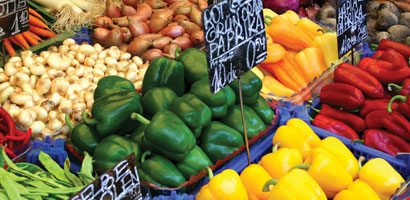Genetically modified fruits and vegetables are safe and nutritious, but consumer acceptance for GM produce continues to be slow in coming.
Genetically modified foods have been present in our food supply for many years. Some healthy GM food products have been developed and made their way onto grocers’ shelves without much protest. However, other products have provoked much consumer resistance, with the term “frankenfoods” often used as a negative connotation. Experts believe this resistance is due to the public’s lack of understanding of what GM really is.
One example of a GM fruit that has been readily accepted by consumers is papaya. According to John Schoenecker of Harris Moran Seed Company, a GM variety has saved the Hawaiian papaya crop. The fruit was being destroyed by papaya ringspot virus which resisted all attempts to control it, but researchers at the University of Hawaii were able to use genetic modification to breed a papaya variety resistant to the virus.
“Consumers may not know about the GM papaya because there is no difference between it and non-GM varieties,” says Schoenecker. “Since it is virtually the same, there is no need to label it as genetically modified.” The first virus resistant papayas were commercially grown in Hawaii in the late 1990s, and transgenic papayas now make up 75 percent of the total Hawaiian papaya crop.
Consumer Perception
Biotechnology can be used to solve many of the world’s food problems. However the general perception has always been that consumers do not want GM fruits and vegetables. But that could be changing as these products begin to have more benefits for consumers and the environment.
“We don’t hear a lot from consumers in the United States regarding GM foods,” comments Elizabeth Pivonka of the Produce for Better Health Foundation. “We don’t get any questions about GM in the ‘ask the expert’ section of our website. Since we have an average of 70,000 unique monthly visitors, plenty of consumers have the opportunity to ask questions or express concerns if they had them.”
Some of the anti-GM feeling seems to stem from consumers in Asian and European countries which, for the most part, do not allow any GM foods to enter their markets. GM crops are hardly grown in many European countries, and are only used as animal feed rather than food for human consumption. The question by those in the industry becomes: “Is the GM papaya less safe than a steak from an animal raised on Bt corn?”
“It seems the resistance to GM food comes from a minority that has more power than the majority,” comments Ko Remijnse of Nunhems, a vegetable seed company based in the Netherlands. “However, studies have shown that the number of groups against GM declines each year.”

At the time of the announcement, India’s Environment Minister Jairam Ramesh said there was not enough public trust to support the introduction of such crops into India’s food supply until more research was done to remove all doubts that GM foods were safe for consumption. “This is bad for the country’s agricultural and biotechnology future. Our scientists have lost their credibility, companies will be unwilling to invest more money, and it will take us a long time to pick up the pieces again,” said C. Kameshwar Rao, an official at the Foundation for Biotechnology Awareness and Education, a GM advocacy institute.
Benefits Could Turn the Tables
However, just as most North American farmers accept GM crops, so do farmers in India. “Farmers in India will buy Bt cotton even though the seed is more expensive because it comes with less problems,” Schoenecker comments. That may be exactly what finally tips the scales in favor of GM foods—the knowledge that less spraying will be needed, less fossil fuel will be consumed if sprays aren’t applied and less harm will occur to the environment and beneficial insects and plants.
“It’s a matter of time, and the world will accept GM fruits and vegetables,” Remijnse continues. “We have been growing GM foods for 25 years and I am sure in another 25 years it will be totally accepted. In those first 25 years there have been no problems with GM, so is that not proof of its safety?”
In the meantime, however, Nunhems is hesitant to pursue GM seed development because of the cost of registering a GM-event and the lack of return on investment should consumers refuse to accept the resulting vegetable crop. Remijnse says it costs $10 to $15 million to register a GM-trait before introduction to market and, with the current small and fragmented vegetable markets, that is too costly.
“GM is an easy topic to cause fear in people,” comments Schoenecker. “It raises questions about playing with nature and yet billions and billions of food servings containing GM products are consumed in the United States each year without any documented case of problems attributed to GM.” He says negative public perception has been driven by lobby groups and bad publicity. His company, which breeds vegetable varieties designed to boost yield, reduce chemical inputs, and increase freshness, flavor and quality, has also put its GM breeding programs on hold pending a change in consumer attitude and “a path to market without as many bumps in it.”
Robert Johnston of Johnny’s Selected Seeds in Maine believes the “American public is neutral about science and doesn’t really have a strong position one way or another.” This neutrality applies to genetic modification when it produces “phantom products,” such as corn syrup in soda.
“It’s only a matter of time before GM is widely accepted,” Johnston continues. “The mass market will accept GM, but there will always be a significant group that is unlikely to accept it, such as proponents of organic practices.”
Continued Education is Key
What has to change and will it really take 25 years, as suggested by Remijnse? The consensus is that more education is needed from all levels of the agricultural industry, which is difficult because seed producers are not, by nature, professional marketers nor do they have the budgets to hire public relations firms to improve the public image of GM fruits and vegetables. That leaves groups such as the Produce for Better Health Foundation, which tries to educate in a technology-driven world.
“We monitor what is in the news in the United States about fruits and vegetables,” says Pivonka. “When there is unfavorable news, like pesticide residue concerns, we try to be a moderate, rational voice to the consumer that addresses the issue with supportive science. To date, we haven’t had to say anything about GM foods.”
Speculation that GM foods will gain acceptance if it can be proved that genetic modification offers health benefits to consumers has so far resulted in little success. The possibility of increasing nutrient content in GM foods to improve health, particularly in impoverished countries, has not yet seemed to appeal to consumers or legislators. Examples of genetic modification breakthroughs, such as inserting vitamin A in rice, have still led to roadblocks in acceptance. Instead, what may finally get GM fruits and vegetables accepted openly in the marketplace is the potential “green” aspect of these products. “Transgenic crops will become an important part of sustainable agriculture,” Schoenecker explains.
“There are negative side effects of over-using computers,” comments Remijnse, but that hasn’t prevented widespread acceptance of that technology. There does indeed seem to be a double standard when it comes to genetic modification of food crops, and until the majority of consumers learn to understand the science behind GM fruits and vegetables, these products will remain off the store shelf. Rosalie I. Tennison













